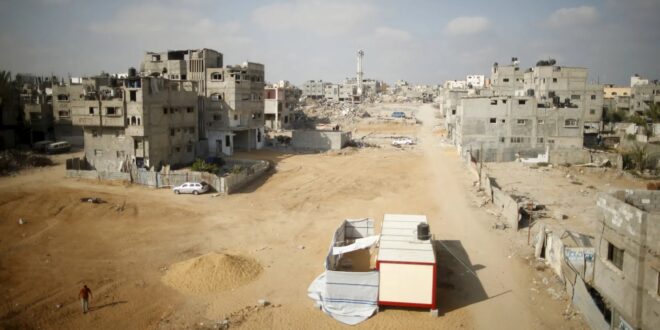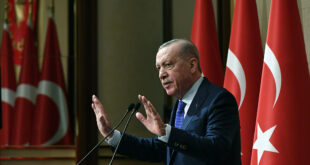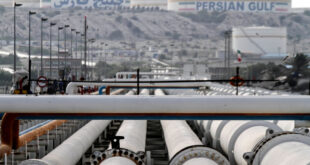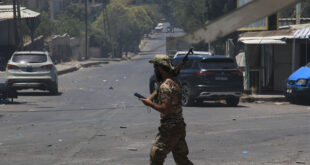For more than a decade, Israel has clashed with Hamas in Gaza, with cycles of violence defined by periods of intense fighting followed by relative lulls. This brief summarizes a report focusing on a five-year period of this conflict — from the end of Operation Cast Lead in 2009 to the end of Operation Protective Edge in 2014.
The report tells many stories and holds many lessons. It analyzes the changing face of urban warfare and how an advanced military fought a weaker, yet highly adaptive, irregular force. It also provides a case study of military innovation — showing how the Israel Defense Forces (IDF) evolved operationally, organizationally, and technologically to meet ongoing hybrid challenges.
Most broadly, though, this is a story of deterrence. Israel never strived for a decisive victory in Gaza. While it could militarily defeat Hamas, Israel could not overthrow Hamas without risking the possibility that a more radical organization would govern Gaza. Nor did Israel want to be responsible for governing Gaza in a postconflict power vacuum. As such, Israel’s grand strategy became “mowing the grass” — accepting its inability to permanently solve the problem and instead repeatedly targeting leadership of Palestinian militant organizations to keep violence manageable.
Dealing with Hamas in Gaza puts Israel in a strategic quandary: It needs to exert enough force to deter Hamas from attacking but not so much that it topples the regime.
Dealing with Hamas in Gaza puts Israel in a strategic quandary: It needs to exert enough force to deter Hamas from attacking but not so much that it topples the regime. As one Israeli defense analyst put it, “We want to break their bones without putting them in the hospital.”
While this story is about one country, Israel, dealing with one foe, it has broader applicability—the IDF’s experiences in Gaza offer valuable lessons about using different types of military technology and operational concepts, conducting urban combat under intense legal and public scrutiny, and deterring nonstate actors.
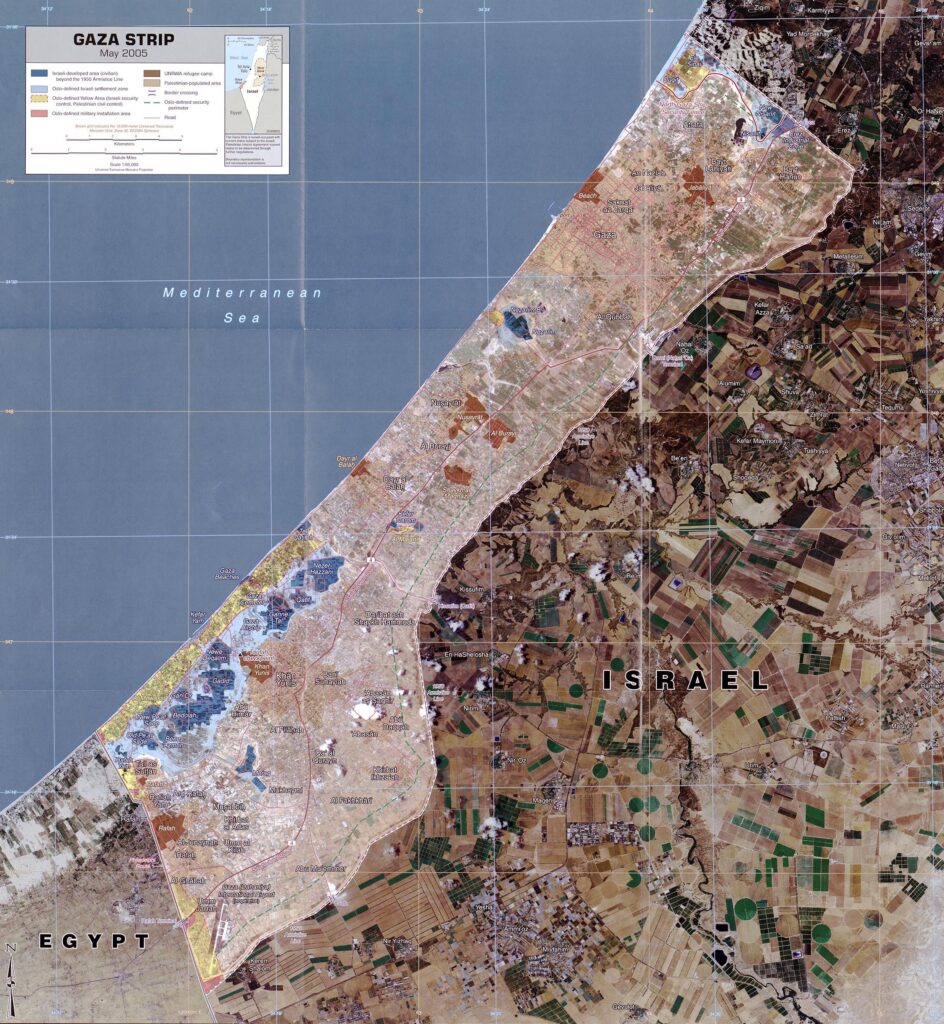
Gaza — Some Context
Following the Six-Day War in 1967 — when Israel captured Gaza and placed it under military administration — Israel has engaged in an ongoing struggle with Palestinians as it developed settlements there. Over time, that struggle led to the First Intifada — a Palestinian uprising over Israeli occupation that lasted from 1987 to 1993 — and the emergence of Hamas, the militant Islamist group that governs Gaza today. Hamas grew in power as leftist secular groups, such as Fatah and the Palestinian Liberation Organization (PLO), lost influence.
The 1993 Oslo Accords ended the First Intifada — creating the Palestinian Authority (PA) as the governing body of the Palestinian people and stipulating that the PLO would recognize Israel’s right to exist. Ultimately, frustration over delays in implementing the Oslo Accords and tensions over Israel’s continued grip on the Palestinians boiled over, sparking the Second Intifada in fall 2000 — a period of intensified Israeli-Palestinian violence. It led Israel to fortify its border with Gaza and in 2005 to withdraw from the territory completely after nearly 40 years of occupation.
In a struggle between Hamas and Fatah, Hamas took over Gaza in 2007, slowly becoming a hybrid actor — part terrorist organization and part pseudo-state — in the process. This is an evolution that continues to play out. Hostilities between Hamas and Israel led to the First Gaza War and to Operation Cast Lead in December 2008 — a war that ended quickly with Israeli victory and withdrawal in late January 2009.
Timeline of Conflict in Gaza
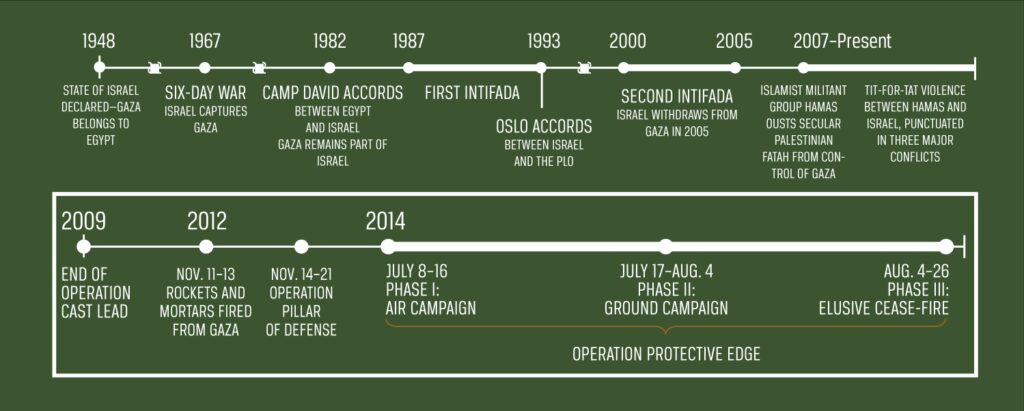
Operation Pillar of Defense
For 20 months after Operation Cast Lead, tensions between Israel and Hamas continued to escalate. Between November 11 and 13, 2012, more than 200 rockets and a number of mortar rounds were fired into Israel from Gaza, wounding dozens of civilians and damaging property. Finally, on November 14, Israel launched Operation Pillar of Defense, with the targeted killing of Hamas military chief Ahmed Jabari and pinpoint attacks against other targets.
Over the eight-day conflict, Hamas and Palestinian Islamic Jihad (PIJ) fired more than 1,456 rockets into Israel, hitting Tel Aviv for the first time since Iraqi Scud attacks during the 1991 Gulf War. In response, the Israeli Air Force struck more than 1,500 targets in Gaza, including rocket launchers, weapon stocks, and Hamas government infrastructure.
Israel mobilized 57,000 reservists and deployed ground forces along Gaza’s border, but the ground incursion never occurred. On November 21, 2012, a cease-fire — brokered by Mohamed Morsi’s Muslim Brotherhood–led Egyptian government — went into effect.
Timeline For Operation Pillar of Defense
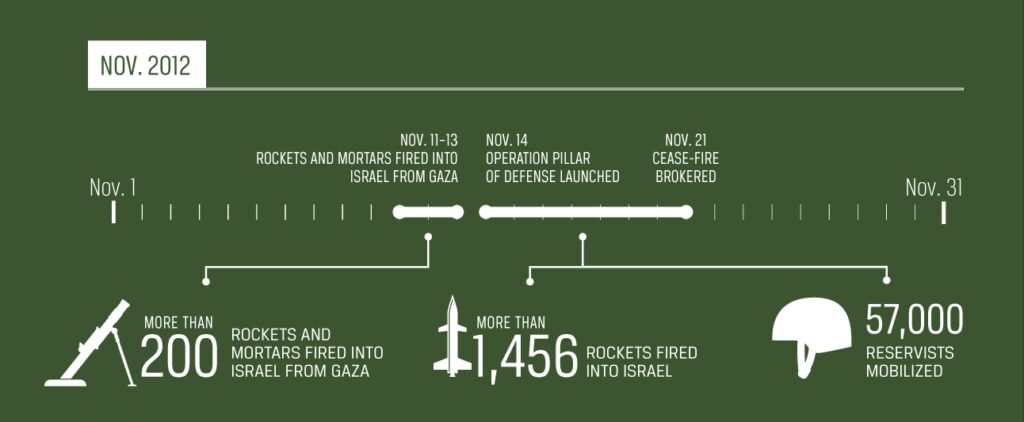
Operation Protective Edge
For a while, Israel and Gaza enjoyed a period of relative calm. But by 2014, Hamas faced strong economic and political pressure. Egypt’s new president, Abdel Fattah el-Sisi, viewed Hamas as allied with his archnemesis, the Muslim Brotherhood, and closed down smuggling tunnels from Egypt to Gaza, denying Hamas one of its key revenue sources. Ultimately, this mixture of political and economic pressures sparked increasing levels of violence.
This violence, in turn, led to Operation Protective Edge, which began on July 8, 2014, and consisted of three phases. The first was an air campaign (July 8–16) that looked similar to Pillar of Defense, with Israel targeting Hamas militants and infrastructure.
However, the air campaign alone could not destroy Hamas’s tunnel network; so, in a second phase, Israel launched a ground incursion (July 17–August 4). Although IDF forces pushed only a few kilometers into Gaza to find and destroy Hamas’s extensive cross-border tunnels, the IDF sporadically encountered fierce pockets of resistance in such places as Shuja’iya, where the IDF Golani Brigade fought one of the most intense battles of the war.
After two weeks of operations, the IDF withdrew, and Protective Edge entered its final “finishing” phase (August 5–26) that was marked by a series of temporary cease-fires broken by air strikes and rocket fire.
Aftermath
Damage Assessment in Gaza

Protective Edge took a toll in both blood and treasure. On the Israeli side, at least 66 soldiers and six civilians died in the conflict. According to the Israeli Tax Authority, Protective Edge caused almost $55 million in direct damage to private and public infrastructure and another $443 million in indirect damage given economic disruptions caused by the conflict.
On the Palestinian side, the United Nations (UN) estimated the number of Palestinian deaths at 2,133, of whom 1,489 were civilians — a point that Hamas used to advance its legal and international claim that Israel used disproportionate force. By contrast, Israeli estimates suggest that there were 1,598 Palestinian fatalities in Protective Edge, of which 75 percent were combatants. In addition, the UN estimated 500,000 people — 28 percent of Gaza’s population — were internally displaced, while the homes of some 108,000 people were uninhabitable.
Israel tries to maintain a difficult balance with respect to Hamas. On one hand, it wants to punish Hamas for its attacks; on the other hand, it does not want to eliminate Hamas because it worries that the organization could be replaced by one that is much more violent.
In the three years after Protective Edge, Hamas has maintained its control in Gaza and does not appear in danger of being replaced in the near term. And yet, the underlying political and economic pressures on Hamas remain today. Thus, many believe a fourth major Gaza conflict is only a matter of time.
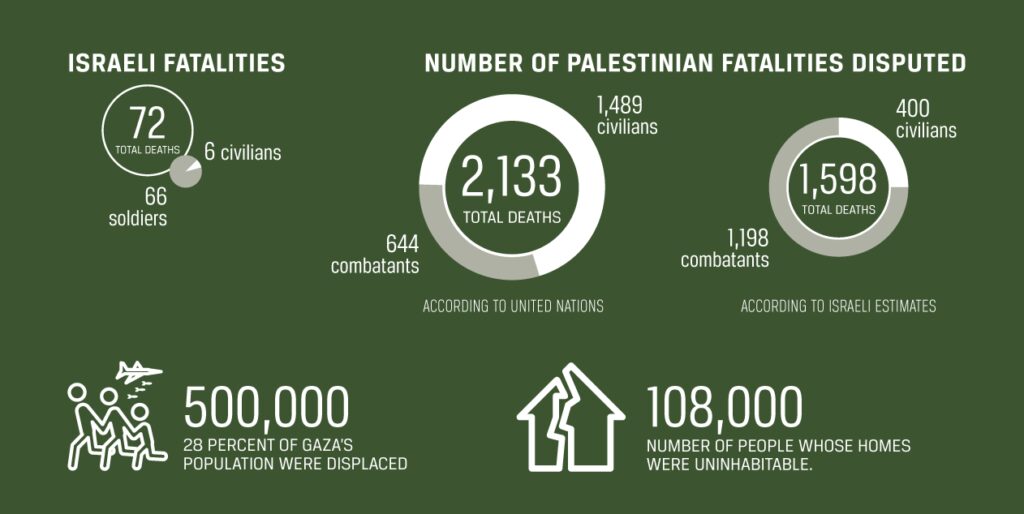
Strategic Lessons
Israel has been a source of vicarious learning for the U.S. military for decades, and these latest Gaza wars are no exception.
Israel is still inexperienced with [lawfare], and it is against its ethos. Israel thinks when they conduct war, no one should interfere. Israel has a long way to go, but is starting to grow up.
An IDF general officer serving on the general staff
- Conflict hinges on perception of success. The first relevant lesson is that in conflicts like Protective Edge, public support for the conflict often hinges more on perceptions of the campaign’s success than it does on casualties — a rethinking about sensitivity to casualties. Israel endured 72 casualties, a significant number given its small population of eight million people (and far more than it suffered in Pillar of Defense or Cast Lead), and yet it fought on with public support — as long as the IDF showed tangible results.
- Reading the Middle East is difficult. The conflict also underscores how difficult it is to read the Middle East. Even before the operation, Israel failed to understand properly how the economic hardship and internal political pressure exerted on Hamas might push conflict in Gaza. Indeed, if the IDF could misjudge Hamas despite being next-door neighbors, then the U.S. military needs to be even more wary about misunderstanding the region.
- Modern militaries must confront lawfare. Protective Edge shows how modern democratic militaries must increasingly confront lawfare — using law as a substitute for traditional military means to achieve a warfighting objective — when combating irregular forces, especially in urban terrain. Protective Edge featured several controversial battles. These engagements became the subject of intense legal scrutiny and a UN-led inquiry, which called into question the IDF’s use of weapons with wide-area effects in densely populated areas and other tactics.
Operational, Tactical, and Technological Lessons
Iron Dome is a blessing because it buys Israel time, but Israel needs an excuse for why they are killing Palestinians in operations. When Iron Dome works so well and so few Israelis die, Israel loses the justification for the operation.
Senior Israeli policymaker
- Precision firepower has limitations. The first lesson has to do with the limits of precision firepower, particularly in dense urban terrain. Ultimately, airpower alone failed to deliver the results the IDF needed during Operation Protective Edge. Despite an intense bombardment during the first week of the conflict, airpower could not achieve tactical results the IDF needed, nor could airpower achieve the broader strategic aim of deterring Hamas and restoring a measure of peace to the region.
- Missile defense has potential. While Iron Dome’s exact effectiveness rates are frequently debated by outside experts, nearly all Israeli experts — inside the IDF and outside government—believe the system works. If true, Iron Dome likely saved lives and limited property damage — and even if not, it certainly relieved political pressure on senior Israeli leaders to bring the conflict to a speedy conclusion and allowed for a more deliberate, if slower, operation.
- There is value in armor and active protective systems. Before Protective Edge, the IDF invested in intelligence and airpower, often at the expense of particularly heavy armor platforms, while after it, the IDF is once again investing in armored vehicles. Active Protective Systems (APS) protected vehicles from rocket-propelled grenades and anti-tank guided munitions and had other indirect benefits on the battlefield, shifting the ways the commanders maneuvered and serving as an intelligence-gathering system.
- Tunnel warfare needs to continue to develop. Even after the conclusion of Protective Edge, the IDF faced real technological challenges with detecting, fighting in, and ultimately destroying tunnels. While the IDF improved in tunnel warfare during the campaign, it still remains an area of concern.
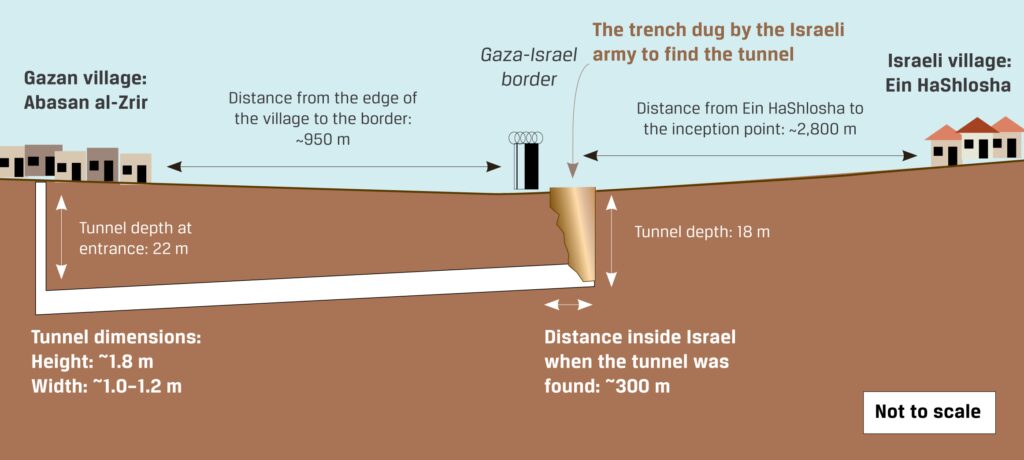
High-Priority Recommendations
Each of the lessons learned has recommendations associated with it, but we focus here on those of more immediate importance for the U.S. Army and the joint force.
Understand the Adversary
During its wars in Gaza, Hamas morphed from an irregular adversary to a hybrid one with qualities that only state actors possessed previously. Israel had to adjust to this changing adversary, much in the way the United States will need to adjust when it moves away from counterinsurgency. The Army needs to train to engage with hybrid adversaries and state actors (Russia, China, Iran, North Korea) with far greater military capabilities than the Army has faced in Iraq and Afghanistan.
Understand the Limits of Precision Targeting in the Urban Context
With the world’s population increasingly living in cities, the Army must anticipate operating more often in urban environments. Adversaries will seek to thwart U.S. overhead-sensing and precision-strike advantages by hiding in the city and among large populations, just as Israel’s adversaries did in Gaza. Ultimately, the Army will need to develop equipment — such as APS — as well as the tactics, techniques, and procedures to operate effectively in this environment.
Develop and Field Rocket and Missile Defenses
Another characteristic of the battlefield in Gaza is the ubiquity of rockets. Missile defense, such as Iron Dome, helped address this problem. The Army and the joint force will face rocket and missile attacks in the future, ranging from limited hybrid adversary capabilities to the sophisticated systems wielded by such states as North Korea. The Army, in particular, needs to develop Service and Joint capabilities to locate rocket and missile launches and bolster its ability to destroy them from a distance. It must also develop defenses to counter them, particularly for fixed sites.
Invest in APS and Armored Vehicles
APS and armored vehicles proved vital in Israeli operations, and they are critical for the U.S. military as well. The Army is testing several solutions to provide protection to its Abrams tanks, Bradley Fighting Vehicles, and Strykers. This effort must proceed as rapidly as possible, even if it only means fielding an interim solution for early deploying units. While materiel solutions are vital, they must be developed within the context of doctrine, organization, training, leadership and education, personnel, and facilities domains.
Prepare for Tunnel Fighting
Operation Protective Edge revealed a dimension of the battlespace that surprised Israel: subterranean operations. Tunnels and other subterranean structures are another way for an adversary to neutralize the intelligence and strike advantages of airpower. Countering tunneling tactics requires ground forces. The Army needs to understand the implications of subterranean operations across the domains of doctrine, organization, training, materiel, leadership and education, personnel, and facilities.
Final Thoughts
There are obvious differences between the security challenges that the United States and Israel face. Still, the two nations have a long history of learning from each other, particularly in understanding when the nature of conflict is changing. Indeed, the 1973 Yom Kippur War was a key catalyst in the development of AirLand Battle and many of the key weapon systems still in the U.S. Army’s arsenal. Today, the Army and the joint force need to continue to learn from IDF’s challenges and successes — and use those lessons to identify gaps in their own approaches. In particular, they must communicate those gaps with urgency to policymakers, given the potential these gaps have to upend future strategies against competent, well-armed, hybrid adversaries.
 Eurasia Press & News
Eurasia Press & News
